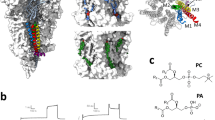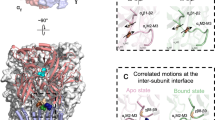Abstract
The ability of the nicotinic acetylcholine receptor (nAChR) to undergo conformational transitions is exquisitely sensitive to its surrounding lipid environment. Previous work has highlighted a conformational selection mechanism, whereby different lipids stabilize different proportions of activatable resting versus nonactivatable conformations. In the absence of anionic lipids and cholesterol, the nAChR adopts an uncoupled conformation, which binds agonist with resting state–like affinity but does not usually undergo agonist-induced conformational transitions. Very slow (minutes to hours) transitions from uncoupled to coupled (resting, open and/or desensitized) conformations, however, can occur in membranes with relatively thick hydrophobic cores. Increasing membrane hydrophobic thickness 'awakens' uncoupled nAChRs by reducing the large activation energy barrier (or barriers) leading to coupled states, thus allowing conformational transitions to occur on an experimentally tractable timescale. Lipids shape activity by modulating the relative proportions of activatable versus nonactivatable conformations and by controlling the transitions between uncoupled and coupled conformations.
This is a preview of subscription content, access via your institution
Access options
Subscribe to this journal
Receive 12 print issues and online access
$259.00 per year
only $21.58 per issue
Buy this article
- Purchase on Springer Link
- Instant access to full article PDF
Prices may be subject to local taxes which are calculated during checkout




Similar content being viewed by others
Accession codes
References
Baenziger, J.E. & Corringer, P.J. 3D structure and allosteric modulation of the transmembrane domain of pentameric ligand-gated ion channels. Neuropharmacology 60, 116–125 (2011).
Barrantes, F.J. Structural basis for lipid modulation of nicotinic acetylcholine receptor function. Brain Res. Brain Res. Rev. 47, 71–95 (2004).
Fong, T.M. & McNamee, M.G. Correlation between acetylcholine receptor function and structural properties of membranes. Biochemistry 25, 830–840 (1986).
Sunshine, C. & McNamee, M.G. Lipid modulation of nicotinic acetylcholine receptor function: the role of membrane lipid composition and fluidity. Biochim. Biophys. Acta 1191, 59–64 (1994).
Brannigan, G., Henin, J., Law, R., Eckenhoff, R. & Klein, M.L. Embedded cholesterol in the nicotinic acetylcholine receptor. Proc. Natl. Acad. Sci. USA 105, 14418–14423 (2008).
Ryan, S.E., Demers, C.N., Chew, J.P. & Baenziger, J.E. Structural effects of neutral and anionic lipids on the nicotinic acetylcholine receptor. An infrared difference spectroscopy study. J. Biol. Chem. 271, 24590–24597 (1996).
Hamouda, A.K., Sanghvi, M., Sauls, D., Machu, T.K. & Blanton, M.P. Assessing the lipid requirements of the Torpedo californica nicotinic acetylcholine receptor. Biochemistry 45, 4327–4337 (2006).
daCosta, C.J. & Baenziger, J.E. A lipid-dependent uncoupled conformation of the acetylcholine receptor. J. Biol. Chem. 284, 17819–17825 (2009).
Li, P. & Steinbach, J.H. The neuronal nicotinic α4β2 receptor has a high maximal probability of being open. Br. J. Pharmacol. 160, 1906–1915 (2010).
Vallejo, Y.F., Buisson, B., Bertrand, D. & Green, W.N. Chronic nicotine exposure upregulates nicotinic receptors by a novel mechanism. J. Neurosci. 25, 5563–5572 (2005).
Unwin, N. Refined structure of the nicotinic acetylcholine receptor at 4Å resolution. J. Mol. Biol. 346, 967–989 (2005).
Baenziger, J.E. & daCosta, C.J.B. Molecular mechanisms of acetylcholine receptor-lipid interactions: from model membranes to human biology. Biophys. Rev. 5, 1–9 (2013).
Lee, A.G. How lipids affect the activities of integral membrane proteins. Biochim. Biophys. Acta 1666, 62–87 (2004).
Holt, A. & Killian, J.A. Orientation and dynamics of transmembrane peptides: the power of simple models. Eur. Biophys. J. 39, 609–621 (2010).
Andersen, O.S. & Koeppe, R.E., II. Bilayer thickness and membrane protein function: an energetic perspective. Annu. Rev. Biophys. Biomol. Struct. 36, 107–130 (2007).
Jensen, M.Ø. & Mouritsen, O.G. Lipids do influence protein function-the hydrophobic matching hypothesis revisited. Biochim. Biophys. Acta 1666, 205–226 (2004).
De Almeida, R.F. et al. Structure and dynamics of the γM4 transmembrane domain of the acetylcholine receptor in lipid bilayers: insights into receptor assembly and function. Mol. Membr. Biol. 23, 305–315 (2006).
Herz, J.M., Johnson, D.A. & Taylor, P. Interaction of noncompetitive inhibitors with the acetylcholine receptor. The site specificity and spectroscopic properties of ethidium binding. J. Biol. Chem. 262, 7238–7247 (1987).
Heidmann, T., Sobel, A., Popot, J.L. & Changeux, J.P. Reconstitution of a functional acetylcholine receptor. Conservation of the conformational and allosteric transitions and recovery of the permeability response; role of lipids. Eur. J. Biochem. 110, 35–55 (1980).
Méthot, N., Demers, C.N. & Baenziger, J.E. Structure of both the ligand- and lipid-dependent channel-inactive states of the nicotinic acetylcholine receptor probed by FTIR spectroscopy and hydrogen exchange. Biochemistry 34, 15142–15149 (1995).
Méthot, N., McCarthy, M.P. & Baenziger, J.E. Secondary structure of the nicotinic acetylcholine receptor: implications for structural models of a ligand-gated ion channel. Biochemistry 33, 7709–7717 (1994).
daCosta, C.J., Michel Sturgeon, R., Hamouda, A.K., Blanton, M.P. & Baenziger, J.E. Structural characterization and agonist binding to human α4β2 nicotinic receptors. Biochem. Biophys. Res. Commun. 407, 456–460 (2011).
Baenziger, J.E. & Méthot, N. Fourier transform infrared and hydrogen/deuterium exchange reveal an exchange-resistant core of α-helical peptide hydrogens in the nicotinic acetylcholine receptor. J. Biol. Chem. 270, 29129–29137 (1995).
Baenziger, J.E., Miller, K.W. & Rothschild, K.J. Fourier transform infrared difference spectroscopy of the nicotinic acetylcholine receptor: evidence for specific protein structural changes upon desensitization. Biochemistry 32, 5448–5454 (1993).
Ryan, S.E., Hill, D.G. & Baenziger, J.E. Dissecting the chemistry of nicotinic receptor-ligand interactions with infrared difference spectroscopy. J. Biol. Chem. 277, 10420–10426 (2002).
Baenziger, J.E. et al. Lipid composition alters drug action at the nicotinic acetylcholine receptor. Mol. Pharmacol. 73, 880–890 (2008).
Ryan, S.E. & Baenziger, J.E. A structure-based approach to nicotinic receptor pharmacology. Mol. Pharmacol. 55, 348–355 (1999).
daCosta, C.J., Ogrel, A.A., McCardy, E.A., Blanton, M.P. & Baenziger, J.E. Lipid-protein interactions at the nicotinic acetylcholine receptor. A functional coupling between nicotinic receptors and phosphatidic acid-containing lipid bilayers. J. Biol. Chem. 277, 201–208 (2002).
daCosta, C.J. et al. Anionic lipids allosterically modulate multiple nicotinic acetylcholine receptor conformational equilibria. J. Biol. Chem. 284, 33841–33849 (2009).
Corringer, P.J. et al. Structure and pharmacology of pentameric receptor channels: from bacteria to brain. Structure 20, 941–956 (2012).
Herz, J.M., Kolb, S.J., Erlinger, T. & Schmid, E. Channel permeant cations compete selectively with noncompetitive inhibitors of the nicotinic acetylcholine receptor. J. Biol. Chem. 266, 16691–16698 (1991).
Jones, O.T. & McNamee, M.G. Annular and nonannular binding sites for cholesterol associated with the nicotinic acetylcholine receptor. Biochemistry 27, 2364–2374 (1988).
Lundbæk, J.A., Andersen, O.S., Werge, T. & Nielsen, C. Cholesterol-induced protein sorting: an analysis of energetic feasibility. Biophys. J. 84, 2080–2089 (2003).
Rankin, S.E., Addona, G.H., Kloczewiak, M.A., Bugge, B. & Miller, K.W. The cholesterol dependence of activation and fast desensitization of the nicotinic acetylcholine receptor. Biophys. J. 73, 2446–2455 (1997).
Kučerka, N., Tristram-Nagle, S. & Nagle, J.F. Structure of fully hydrated fluid phase lipid bilayers with monounsaturated chains. J. Membr. Biol. 208, 193–202 (2005).
Rawicz, W., Olbrich, K.C., McIntosh, T., Needham, D. & Evans, E. Effect of chain length and unsaturation on elasticity of lipid bilayers. Biophys. J. 79, 328–339 (2000).
Blume, A., Hubner, W. & Messner, G. Fourier transform infrared spectroscopy of 13C=O-labeled phospholipids hydrogen bonding to carbonyl groups. Biochemistry 27, 8239–8249 (1988).
Sturgeon, R.M. & Baenziger, J.E. Cations mediate interactions between the nicotinic acetylcholine receptor and anionic lipids. Biophys. J. 98, 989–998 (2010).
Schmidt, D., del Marmol, J. & MacKinnon, R. Mechanistic basis for low threshold mechanosensitivity in voltage-dependent K+ channels. Proc. Natl. Acad. Sci. USA 109, 10352–10357 (2012).
Greisen, P. Jr. et al. Linear rate-equilibrium relations arising from ion channel-bilayer energetic coupling. Proc. Natl. Acad. Sci. USA 108, 12717–12722 (2011).
Cymes, G.D. & Grosman, C. Pore-opening mechanism of the nicotinic acetylcholine receptor evinced by proton transfer. Nat. Struct. Mol. Biol. 15, 389–396 (2008).
Unwin, N. & Fujiyoshi, Y. Gating movement of acetylcholine receptor caught by plunge-freezing. J. Mol. Biol. 422, 617–634 (2012).
Xu, Y. et al. Conformational dynamics of the nicotinic acetylcholine receptor channel: a 35-ns molecular dynamics simulation study. J. Am. Chem. Soc. 127, 1291–1299 (2005).
Haeger, S. et al. An intramembrane aromatic network determines pentameric assembly of Cys-loop receptors. Nat. Struct. Mol. Biol. 17, 90–98 (2010).
Doyle, D.A. et al. The structure of the potassium channel: molecular basis of K+ conduction and selectivity. Science 280, 69–77 (1998).
de Planque, M.R. & Killian, J.A. Protein-lipid interactions studied with designed transmembrane peptides: role of hydrophobic matching and interfacial anchoring. Mol. Membr. Biol. 20, 271–284 (2003).
Gleason, N.J. et al. Tyrosine replacing tryptophan as an anchor in GWALP peptides. Biochemistry 51, 2044–2053 (2012).
Borroni, V. & Barrantes, F.J. Cholesterol modulates the rate and mechanism of acetylcholine receptor internalization. J. Biol. Chem. 286, 17122–17132 (2011).
Baier, C.J., Gallegos, C.E., Levi, V. & Barrantes, F.J. Cholesterol modulation of nicotinic acetylcholine receptor surface mobility. Eur. Biophys. J. 39, 213–227 (2010).
Bretscher, M.S. & Munro, S. Cholesterol and the Golgi apparatus. Science 261, 1280–1281 (1993).
Labriola, J.M. et al. Phospholipase C activity affinity purifies with the Torpedo nicotinic acetylcholine receptor. J. Biol. Chem. 285, 10337–10343 (2010).
Acknowledgements
This research was funded by research grants 12197 and 111243 to J.E.B. from the Canadian Institutes of Health Research (CIHR) as well as a CIHR Fellowship to C.J.B.d.
Author information
Authors and Affiliations
Contributions
J.E.B. and C.J.B.d. designed the research. C.J.B.d., L.D. and J.P.D.T. performed purifications and reconstitutions and both IR and fluorescence experiments. J.E.B., C.J.B.d., L.D. and J.P.D.T. analyzed the data. J.E.B. and C.J.B.d. wrote the paper, with J.E.B. and J.P.D.T. generating the figures.
Corresponding author
Ethics declarations
Competing interests
The authors declare no competing financial interests.
Supplementary information
Supplementary Text and Figures
Supplementary Results and Supplementary Figures 1–10. (PDF 1507 kb)
Rights and permissions
About this article
Cite this article
daCosta, C., Dey, L., Therien, J. et al. A distinct mechanism for activating uncoupled nicotinic acetylcholine receptors. Nat Chem Biol 9, 701–707 (2013). https://doi.org/10.1038/nchembio.1338
Received:
Accepted:
Published:
Issue Date:
DOI: https://doi.org/10.1038/nchembio.1338
This article is cited by
-
Ion channels as lipid sensors: from structures to mechanisms
Nature Chemical Biology (2020)
-
A lipid site shapes the agonist response of a pentameric ligand-gated ion channel
Nature Chemical Biology (2019)
-
The roles of aromatic residues in the glycine receptor transmembrane domain
BMC Neuroscience (2018)
-
An allosteric link connecting the lipid-protein interface to the gating of the nicotinic acetylcholine receptor
Scientific Reports (2018)
-
Challenges and approaches to understand cholesterol-binding impact on membrane protein function: an NMR view
Cellular and Molecular Life Sciences (2018)



